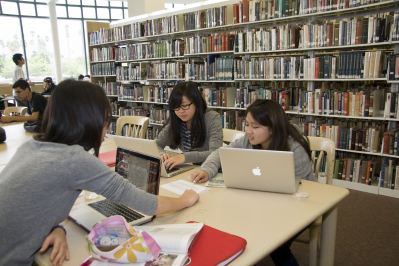Teaching for Learning: Information Literacy
Update December 2020:
This web page is a companion to the 2016 version of the School Library Program Rubric. NYSED released an updated School Library Program Rubric in December 2020.
Student Snapshot: Students practice critical thinking, know when information is needed, locate, evaluate, and use information effectively, and ask questions about its validity.
According to the Association of College and Research Libraries (2015) information literacy is the set of integrated abilities encompassing the reflective discovery of information, the understanding of how information is produced and valued, and the use of information in creating new knowledge and participating ethically in communities of learning.
Source: Association of College and Research Libraries. “Framework for Information Literacy for Higher Education.” American Library Association, 2015.
Citation for Photo: Richshell, Allen. Snapshot Day_PCC Library 010. 2010. Pasadena City College, California. Pasadena City College.
This web page features a photo that was posted with permission from Allen Richshell.
In Practice
The Empire State Information Fluency Continuum
Description: The ESIFC emphasizes the importance of inquiry in learning and establishes information fluency standards for grades K-12, which are aligned with Common Core Learning Standards. The fusion of the two sets of standards aims to create students who are capable of absorbing and applying appropriate information to any situation. The document identifies three information literacy standards which encourage students to be thinkers, explorers, and citizens and outlines the essential steps of inquiry: connect, wonder, investigate, construct, express, and reflect. The continuum also includes grade-specific benchmarks for information skill development and sample diagrams and worksheets which may be used to assess students’ progress. Finally, there is a helpful chart for administrators, teachers, and librarians that links progress along the fluency continuum with various Common Core Learning Standards in reading, writing, and speaking & listening. The continuum helps apply Common Core Learning Standards to real-world classroom teaching and is a great resource to use for grade-specific lesson planning.
Resource/Citation: New York City School Library System. “The Empire State Information Fluency Continuum”. Engage NY, 7 Nov. 2014.
School Library Standards for Learners, School Librarians, and School Libraries
Description: AASL’s integrated standards are designed to empower leaders to transform teaching and learning. The National School Library Standards for Learners, School Librarians, and School Libraries reflect an evolution of AASL Standards, building on philosophical foundations and familiar elements of previous standards while featuring the new streamlined AASL Standards Integrated Framework for learners, school librarians, and school libraries.
Resource/Citation: American Association of School Librarians. National School Library Standards for Learners, School Librarians, and School Libraries. ALA, 2017.
AASL/ACRL Information Literacy Toolkit
Description: This toolkit walks librarians through the process of implementing and promoting plans for information literacy at their schools. Topics include reaching out to other librarians, assessing students, and literacy standards. The toolkit includes templates and links to additional resources.
Resource/Citation: Association of College and Research Libraries. “AASL/ACRL Information Literacy Toolkit”. Association of College and Research Libraries.
Building Literacy with Popular Web 2.0 Tools
Description: This resource from the International Society for Technology in Education reviews the growing use of digital tools in the classroom, then describes four classrooms that use four different approaches - blogging, Edmodo, Wordle, and Audacity - to demonstrate the tools’ potential. While it focuses on classrooms, librarians can apply these techniques independently or in collaboration with teachers to promote literacy.
Resource/Citation: Abshire, Sheryl R., Cynthia D. Cummings, Diane R. Mason, and L. Kay Abernathy. "Building Literacy with Popular Web 2.0 Tools." International Society for Technology in Education, 2014.
The Big 6
Description: The Big 6 is an information and technology literacy model and curriculum, implemented in thousands of schools from kindergarten through higher education.
Resource/Citation: Big6. Information and Technology Skills for Student Success. The Big 6.
In Theory
21st Century Information Literacy Standards for the Digital Learners of New York
Description: These standards emphasize the role of librarians and the importance of reading and information literacy as tools to understand the world. They describe how digital learners think, learn, and share their knowledge and highlight an appreciation for information.
Resource/Citation: New York Library Association. “21st Century Information Literacy Standards for the Digital Learners of New York”. The New Middle School.
About Information Literacy
Description: This article from the University of Texas provides a brief overview of Informational Literacy targeted at librarians. It focuses on why students need to be information literate and the skills they can learn.
Resource/Citation: University of Texas Libraries. "About Information Literacy." University of Texas, 14 Mar. 2014.
Inquiry Model Teacher’s Guide
Description: This curriculum guides educators and identifies characteristics of learners who are information literate.
Resource/Citation: WSWHE BOCES. “Inquiry Model Teacher's Guide”. WSWHE BOCES, 2011.
Consultant
Name: Michael Dodes
Email: mdodes2@schools.nyc.gov
Bio: Michael Dodes had been a Library Media Specialist serving high needs students in the Bronx and Harlem for more than 9 years prior to becoming a Library Coordinator for the New York City Department of Education in 2016.







